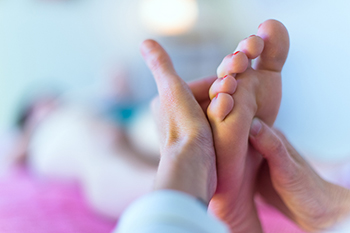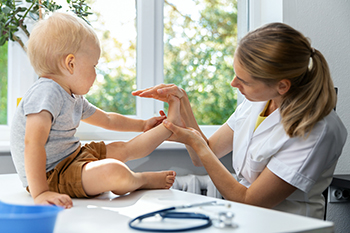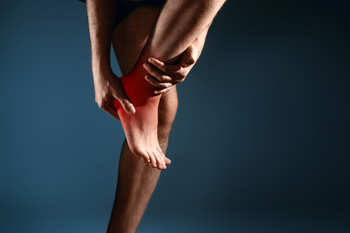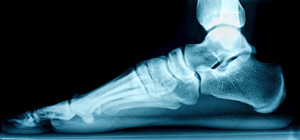Ainsley Roberson Rusevlyan, DPM
(252) 946-1181Washington, NC

Many people enjoy getting foot massages. There are several benefits that patients can receive with regular foot massages including improved blood circulation, reduced blood pressure, and the ability to sleep better. Additionally, it may help existing foot injuries to heal faster due to increased flexibility in the foot and ankle. Patients can report a feeling of overall well-being and anxiety may be significantly reduced. Pregnant women can experience edema, which is excess fluid that builds up in the ankles. Having frequent foot massages may help to relieve some of the discomforts that accompany edema. Research has indicated that the activity of white blood cells may increase and this can help boost the immune system. When the feet are being massaged, the therapist may notice certain foot conditions that have developed, including corns, ingrown toenails, or cracked skin. These are conditions that are treated by a podiatrist. It is suggested that you schedule a consultation to discuss effective treatment options and to learn about other types of foot therapies.
Foot therapy is often necessary for those recovering from either foot deformities or foot injuries. If you have concerns regarding therapy, Ainsley Rusevlyan, DPM of InStride Roberson Footcare. Our doctor can provide the care you need to keep you pain-free and on your feet.
Most Common Injuries
People who are active or athletes are prone to a variety of injuries. Therefore, it is often important to take part in physical therapy in order to quickly get back on the right track.
What to Do When Injured
Physical Therapy – This specialized treatment will focus on the affected area, speeding up recovery and the overall healing process. It is a proven method that has helped millions of people return from any injury.
During physical therapy you will undergo regimented training to get back into full form. Training is often very difficult, especially at first when the foot feels weak. Physical therapy often involves:
Basic stretching and twisting exercises – getting the feet’s mobility and flexibility up.
Massaging – the therapist will massage the injured area in order to activate the muscles and relax them.
Strengthening Exercises – this allows the muscles in the affected area to regain their full strength, a vital step towards full recovery.
If you have any questions please feel free to contact our office located in Washington, NC . We offer the newest diagnostic tools and technology to treat your foot and ankle needs.

As a parent or guardian, you may wonder if your young child’s stance or gait is normal as they learn how to stand and walk. As your child grows, most issues will work themselves out, but there are some things you should monitor. When babies are born, they do not have arches, which is known as having flat feet. Typically, by the time a child is 6 years old, their arch is developed and visible when they stand. Around the age of 4, many children will have a small gap between their ankles when standing with their knees together (knock knees) which should go away by the age of 6 or 7 when their legs straighten out fully. If the gap is between both their knees and ankles, this is known as bow legs. This condition is commonly present in children less than 18 months old. Some young children walk on their tiptoes (tiptoe walking) until approximately 3 years of age, and thereafter will usually adopt the normal heel-to-toe walking pattern. Feet that turn in (in-toeing) or turn out (out-toeing) will usually start pointing straight by themselves when the child is roughly 8 years old. Regular check-ups with a podiatrist will help ensure that your child’s feet are developing normally. Also, if the issues mentioned here do not go away on their own, or you have any concerns about your child’s foot or ankle health, have your child examined by a podiatrist right away.
Making sure that your children maintain good foot health is very important as they grow. If you have any questions, contact Ainsley Rusevlyan, DPM of InStride Roberson Footcare. Our doctor can provide the care you need to keep you pain-free and on your feet.
Keeping Children's Feet Healthy
Having healthy feet during childhood can help prevent medical problems later in life, namely in the back and legs. As children grow, their feet require different types of care. Here are some things to consider...
Although babies do not walk yet, it is still very important to take care of their feet.
Avoid putting tight shoes or socks on his or her feet.
Allow the baby to stretch and kick his or her feet to feel comfortable.
As a toddler, kids are now on the move and begin to develop differently. At this age, toddlers are getting a feel for walking, so don’t be alarmed if your toddler is unsteady or ‘walks funny’.
As your child gets older, it is important to teach them how to take care of their feet.
Show them proper hygiene to prevent infections such as fungus.
Be watchful for any pain or injury.
Have all injuries checked by a doctor as soon as possible.
Comfortable, protective shoes should always be worn, especially at play.
If you have any questions please feel free to contact our office located in Washington, NC . We offer the newest diagnostic and treatment technologies for all your foot and ankle needs.

There are 26 bones, several tendons, and ligaments that each foot is composed of. Many people worldwide will experience foot pain at least once during their lifetime. There are many causes of foot pain. It can be related to diabetes, inflammation, or wearing shoes that do not fit correctly. An uncomfortable foot condition known as athlete’s foot can cause itching and redness. A bunion is defined as a bony lump that forms on the side of the big toe. It can be bothersome while wearing shoes and many patients need to purchase larger shoes and socks. Bunions can develop due to genetic reasons or from wearing shoes that do not have adequate room for the toes to move freely in. Patients with an ingrown toenail are often familiar with the pain and discomfort this ailment can cause. In severe cases, there might be a discharge, which may be indicative of an infection. Heel pain that is worse in the morning is usually linked to a condition called plantar fasciitis. If you have any foot pain and would like a proper diagnosis and to begin an effective treatment plan, please schedule an appointment with a podiatrist.
Foot Pain
Foot pain can be extremely painful and debilitating. If you have a foot pain, consult with Ainsley Rusevlyan, DPM from InStride Roberson Footcare. Our doctor will assess your condition and provide you with quality foot and ankle treatment.
Causes
Foot pain is a very broad condition that could be caused by one or more ailments. The most common include:
Diagnosis
To figure out the cause of foot pain, podiatrists utilize several different methods. This can range from simple visual inspections and sensation tests to X-rays and MRI scans. Prior medical history, family medical history, and any recent physical traumatic events will all be taken into consideration for a proper diagnosis.
Treatment
Treatment depends upon the cause of the foot pain. Whether it is resting, staying off the foot, or having surgery; podiatrists have a number of treatment options available for foot pain.
If you have any questions, please feel free to contact our office located in Washington, NC . We offer the newest diagnostic and treatment technologies for all your foot care needs.

The foot condition that is known as flat feet is apparent as the patient stands up and the entire foot lies on the floor. The medical term for this ailment is referred to as rigid pes planus, and may cause discomfort. Most babies are born with flexible flat feet, and the arch will fully develop by approximately seven years of age. Adults that have flat feet may have inherited loose ligaments, and may have extreme flexibility throughout their body. Rigid flat foot can be the result of a problem that affects the foot structure. The reasons for this can include congenital vertical talus, in which the bones in the foot are aligned improperly. This is considered to be a rare condition the patient is born with. Tarsal coalition exists when two or more of the foot bones are fused together, and often affects the flexibility of the entire foot. The condition that is known as lateral subtalar dislocation can affect people who have a normal arch, and the bone within the arch becomes dislocated. If you have flat feet for any reason, it is strongly suggested that you are under the care of a podiatrist who can accurately treat this condition.
Flatfoot is a condition many people suffer from. If you have flat feet, contact Ainsley Rusevlyan, DPM from InStride Roberson Footcare. Our doctor will treat your foot and ankle needs.
What Are Flat Feet?
Flatfoot is a condition in which the arch of the foot is depressed and the sole of the foot is almost completely in contact with the ground. About 20-30% of the population generally has flat feet because their arches never formed during growth.
Conditions & Problems:
Having flat feet makes it difficult to run or walk because of the stress placed on the ankles.
Alignment – The general alignment of your legs can be disrupted, because the ankles move inward which can cause major discomfort.
Knees – If you have complications with your knees, flat feet can be a contributor to arthritis in that area.
Symptoms
Treatment
If you are experiencing pain and stress on the foot you may weaken the posterior tibial tendon, which runs around the inside of the ankle.
If you have any questions please feel free to contact our office located in Washington, NC . We offer the newest diagnostic and treatment technologies for all your foot and ankle needs.